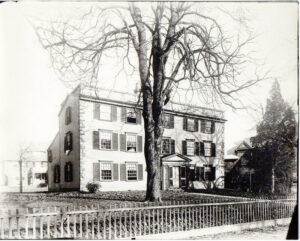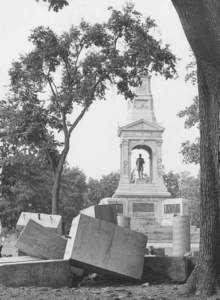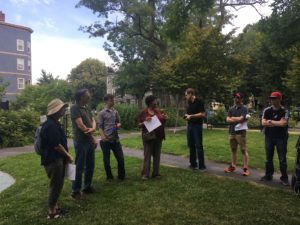A Dead-End that Led to a Deadly End
By Michael Kenney, 2012
Unless you have a parking space in Stone Court, chances are you have driven right past it, heading up Massachusetts Avenue toward Porter Square. But in olden times you would have shuddered as you passed by and perhaps felt a chill, because then it was known as “The Way to Gallows Hill.”
As one of the four towns in the Bay Colony where courts were held, Cambridge had not only a courthouse and a house of correction but also a place of execution. In the Cambridge Historical Society’s Proceedings for 1923, historian Thomas Francis O’Malley wrote that “here as elsewhere,” the place of execution “was located upon the common land and a bit removed from the more thickly settled part of the community.” It was reached “by a bridle path or cart way from the Great County Road.” The gallows itself probably stood near what is now 15-19 Lancaster St.
“It is perhaps not too much to say,” O’Malley wrote, “that all of the executions ordered in Middlesex County took place on this lot until 1817,” when the East Cambridge jail was built. The earliest was likely that of Goody Kendall, probably by 1701. As the court records put it, Kendall “did bewitch to death a child of Goodman Genings [probably Robert or Samuel Jennings].” The best known executions were those in 1755 of Mark and Phillis, two enslaved people accused in the death by poisoning of Captain John Codman, a Charlestown merchant whose “rigid discipline” they had found “unendurable.” Phillis, as was customary, was strangled and her body burned. Mark was hanged and his body suspended in irons on a gibbet along what is now Washington Street in Somerville, near the Charlestown line. Paul Revere, on his famous ride of April 1775, recalled passing “nearly opposite where Mark was hung in chains.”
The last known execution on Gallows Hill took place in 1817 and was witnessed by the seven-year-old Oliver Wendell Holmes, who “received a vigorous scolding as a result.”
The haunted history of Gallows Hill apparently did not deter Anson Stone, the treasurer of the Mercantile Savings Bank, from building his house in 1847 at the corner of Massachusetts Avenue and “The Way to Gallows Hill,” which now carries his name. The house was razed in 1936, and the dead-end Stone Court is a private parking lot.






